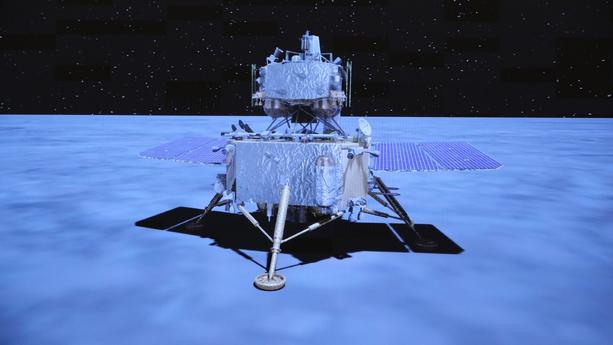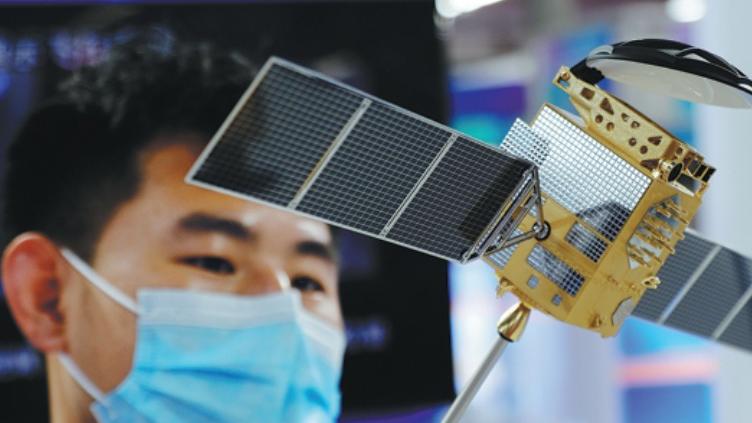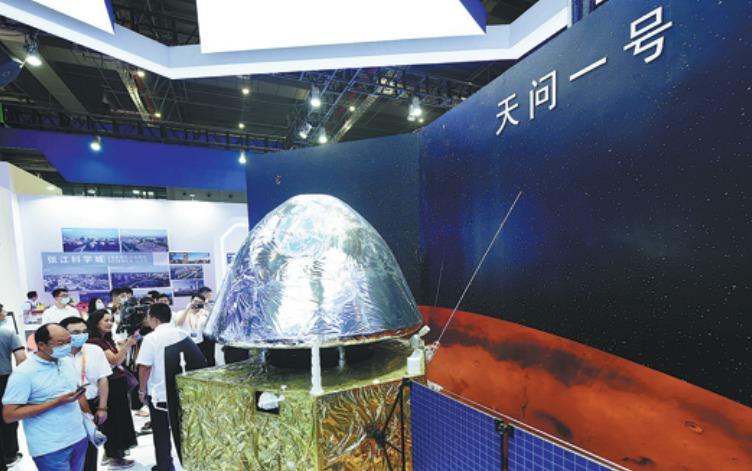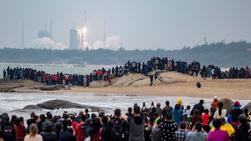 This photo taken at Beijing Aerospace Control Center shows an image of China's Chang'e 5 robotic lunar probe landing on the moon on Dec 1, 2020. (PHOTO / XINHUA)
This photo taken at Beijing Aerospace Control Center shows an image of China's Chang'e 5 robotic lunar probe landing on the moon on Dec 1, 2020. (PHOTO / XINHUA)
China’s space industry produced a remarkable scorecard last year, characterized by the nation’s first independent Mars mission, the completion of a global navigation satellite network and a landmark achievement that saw rock and soil samples retrieved from the moon.
The most significant event in the field for China as well as one of the most notable space activities globally, the Chang’e 5 robotic mission returned to Earth with 1,731 grams of lunar rock and soil, marking a historic accomplishment 44 years after the last lunar substances were retrieved.
The 23-day mission was China’s first space journey to claim extraterrestrial samples, making it the third country to accomplish the feat after the United States and the former Soviet Union.
In a letter published after the samples arrived on Earth, President Xi Jinping, who is also general secretary of the Communist Party of China Central Committee and chairman of the Central Military Commission, extended warm congratulations to all participants in the mission.
Xi said that as China’s most complicated space project, the Chang’e 5 mission completed the national space industry’s first extraterrestrial sampling and return. It was the latest achievement by China’s system, which is characterized by its ability to mobilize all available resources to overcome difficulties and achieve its goals, and also marks a major step forward for the country’s space industry, he said.
The mission’s results will contribute to mankind’s deeper understanding of the moon’s origins and the evolution of the solar system, he noted.
“Your extraordinary feats will be enshrined in the memories of our motherland and the people,” Xi wrote, referring to those involved in the mission.
He encouraged them to continue to build the country into a major power in space, make new contributions to national rejuvenation, and give a stronger boost to the peaceful use of space and the building of a shared future for humanity.
The robotic lunar mission ended successfully early on Dec 17, when Chang’e 5’s re-entry capsule, carrying the samples gathered from the moon, landed in northern China’s grasslands.
The sealed samples were transferred to a specially designed laboratory at the Chinese Academy of Sciences and will later be distributed to researchers for analysis, experiments and tests.
“Research on lunar samples is one of the most important ways we can learn about the past, present and future of the moon, and also provides great help when scientists investigate the evolution of other members of our solar system,” said Guo Hongfeng, a researcher at CAS’ National Astronomical Observatories.
Some of the samples will be put on display to boost scientific awareness, especially among the younger generation.
China National Space Administration officials have welcomed cooperation from foreign scientists in studying the samples.
China’s largest and most advanced lunar probe, Chang’e 5 had four main components: an orbiter, lander, ascender and re-entry capsule. The probe was launched by a Long March 5 heavy-lift carrier rocket early on Nov 24 at the Wenchang Space Launch Center in southern China’s Hainan province, setting out on China’s most difficult space mission and the world’s first to retrieve lunar samples since 1976.
According to the space administration, the Chang’e 5 mission was designated to fulfill several objectives. In terms of space engineering, it should demonstrate and verify technical plans and apparatus for autonomous lunar sampling and packing as well as moon-based launching and lunar orbital docking.
In the scientific context, it was tasked with investigating the landing site’s geological and topographic features, and enabled scientists to analyze lunar samples’ structure and physical traits that can deepen their research into the moon’s origins and evolution.
The mission also aimed to help foster the country’s knowledge, technology and talent pool for future manned lunar missions and other deep-space expeditions.
After the re-entry capsule’s landing was announced, Thomas Zurbuchen, associate administrator of NASA’s Science Mission Directorate, wrote on social media: “Congratulations to China on today’s return of lunar samples to Earth! The international science community celebrates your successful Chang’e 5 mission. These samples will help reveal secrets of our Earth-moon system and gain new insights about the history of our solar system.”
In 2020, China launched a total of 39 carrier rockets, four of which failed to transport payloads into space.
Three Long March 5-series rockets were launched last year, carrying into space China’s next-generation manned spacecraft, the country’s first independent Mars probe and the landmark Chang’e 5 lunar sample-return.
In 2021, China’s most significant space flights will all involve the nation’s manned space station program, scheduled to begin construction in the coming months.
The first important launch is set to take place in the first half of the year to deploy the core module of the country’s first space station, according to the China Manned Space Agency.
After this launch, astronauts in the Shenzhou XII and XIII missions and two cargo ships will be lofted within months to prepare the module for future docking with other parts of the station.
In the next two years, a total of 11 Long March 5B, Long March 7 and Long March 2F missions will put the station’s major components into orbit and shuttle astronauts there to assemble the space-based facility.
According to program planners, the space station is expected to become fully operational around 2022 and is set to operate for about 15 years.
Milestones
 China's new large carrier rocket Long March 5B makes its first flight at the Wenchang Space Launch Center in Hainan province on May 5, 2020. (SU DONG / CHINA DAILY)
China's new large carrier rocket Long March 5B makes its first flight at the Wenchang Space Launch Center in Hainan province on May 5, 2020. (SU DONG / CHINA DAILY)
Long March 5B
China’s Long March 5B carrier rocket made its first flight on May 5 at the Wenchang center marking a new chapter in the country’s manned space program.
The Long March 5B is central to the nation’s space station program as it is the only Chinese launch vehicle capable of carrying large space station parts into orbit.
 This undated photo shows an attendee looking at a model of a Beidou Navigation Satellite at an expo in Shenyang, Liaoning province, in September, 2020. (HUANG JINKUN / FOR CHINA DAILY)
This undated photo shows an attendee looking at a model of a Beidou Navigation Satellite at an expo in Shenyang, Liaoning province, in September, 2020. (HUANG JINKUN / FOR CHINA DAILY)
Beidou Satellite
On June 23, the final satellite to complete the third-generation network of the Beidou Navigation Satellite System was launched by a Long March 3B rocket at the Xichang Satellite Launch Center, Sichuan province.
After in-orbit tests, the satellite started formal operations in late July, marking the start of Beidou’s provision of full-scale global services.
Beidou is China’s largest space-based system and one of four global navigation networks, along with the GPS of the US, Russia’s GLONASS and the European Union’s Galileo.
 In this undated photo, visitors look at a model of the landing capsule Tianwen 1 in Shanghai in September, 2020. (LONG WEI / CHINA DAILY)
In this undated photo, visitors look at a model of the landing capsule Tianwen 1 in Shanghai in September, 2020. (LONG WEI / CHINA DAILY)
Tianwen 1
In addition to the moon, China’s space authorities are looking farther into the solar system. They took the first step in the country’s interplanetary voyage during the summer.
On July 23, Tianwen 1, China’s first independent Mars mission, was launched from the Wenchang center by a Long March 5 rocket, opening the nation’s planetary exploration program.
If everything goes according to schedule, the probe will travel more than 470 million km before being captured by Mars’ gravitational field in February.
After entering Mars’ orbit, the spacecraft will circle the planet for two and a half months to examine the preset landing site before descending to release the capsule.
 A crowd watches the launch of China's new medium-lift carrier rocket Long March 8 in Wenchang, Hainan province, on Dec 22, 2020. (LIU YANG / FOR CHINA DAILY)
A crowd watches the launch of China's new medium-lift carrier rocket Long March 8 in Wenchang, Hainan province, on Dec 22, 2020. (LIU YANG / FOR CHINA DAILY)
The Long March 8
The Long March 8, the newest carrier rocket, conducted its debut flight on Dec 22 at the Wenchang Space Launch Center.
The mission marked the 356th flight of the Long March rocket family, the pillar of China’s space transport system.
Xiao Yun, the rocket’s project manager, said the successful maiden flight was a new achievement in China’s efforts to upgrade its medium-lift launch vehicle system, and will push forward the nation’s efforts to become a world-class space power.
 A Long March 4C rocket carrying Yaogan 33 satellite blasts off from the Jiuquan Satellite Launch Center in northwest China on Dec 27, 2020. (WANG JIANGBO / FOR CHINADAILY.COM.CN)
A Long March 4C rocket carrying Yaogan 33 satellite blasts off from the Jiuquan Satellite Launch Center in northwest China on Dec 27, 2020. (WANG JIANGBO / FOR CHINADAILY.COM.CN)
Long March 4C
China launched a Long March 4C carrier rocket late on Dec 27, bringing an end to its annual space plan for 2020.
The rocket lifted off at the Jiuquan Satellite Launch Center in the Gobi Desert, deploying the Yaogan 33 remote-sensing satellite and a small experimental satellite into a sun-synchronous orbit.
Long March 4C is mainly used to send satellites to sun-synchronous orbit.


